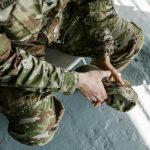You rely on puncture-proof Kevlar fabric to keep you safe in extreme scenarios. It shields military and first responder gear from sharp objects and blasts while maintaining flexibility. In industrial and construction settings, it protects against cuts and punctures from tools and debris. Kevlar also fortifies automotive, aerospace parts, and sporting gear with lightweight, durable defense. From firefighting apparel to medical protection, it guards against hazards without bulk. Explore how Kevlar tackles risks across diverse high-stress environments.
Table of Contents
Key Takeaways
- Kevlar fabric offers exceptional puncture resistance in military gear, protecting soldiers from blades, shrapnel, and bullets in combat zones.
- Firefighters and first responders rely on Kevlar for cut-resistant, flame-resistant clothing and gloves in hazardous emergency situations.
- Industrial and construction workers use Kevlar-reinforced gloves and protective wear to guard against sharp tools and puncture hazards.
- Automotive and aerospace industries utilize Kevlar to reinforce parts, providing lightweight puncture protection that enhances safety and performance.
- Medical and personal protective equipment incorporate Kevlar to prevent needle sticks and sharp object injuries while maintaining dexterity and comfort.
Military and Tactical Gear
Although you mightn’t see it, Kevlar fabric plays an essential role in military and tactical gear by providing reliable puncture resistance.
When you wear Kevlar-lined body armor or helmets, you’re protected from sharp objects and shrapnel that could otherwise cause serious injury. You’ll find this fabric woven into vests, gloves, and even vehicle panels, all designed to withstand extreme conditions and threats.
Kevlar’s strength doesn’t just stop punctures; it helps reduce the impact of blades and bullets, keeping you safer on the battlefield.
Protective Clothing for First Responders
When you’re on the front lines as a first responder, you need clothing that offers enhanced cut resistance and keeps you safe from sharp hazards.
Kevlar fabric provides lightweight thermal protection, so you stay comfortable without extra bulk.
Plus, its durability guarantees your gear holds up in the toughest conditions you face every day.
Enhanced Cut Resistance
Since first responders face sharp objects and hazardous environments daily, they need protective clothing with enhanced cut resistance.
Kevlar fabric offers you that vital edge, combining high tensile strength with flexibility. This means your gear resists cuts and slashes from knives, glass shards, and other sharp debris without restricting movement.
Enhanced cut resistance reduces injury risk, letting you focus on saving lives instead of worrying about your safety.
When you wear Kevlar-based clothing, you gain durable protection that withstands wear and tear during intense operations. Its lightweight nature guarantees you stay agile, while the fabric’s puncture-proof qualities add an extra layer of defense.
Choosing Kevlar means you’re better prepared to handle dangerous situations confidently and effectively.
Lightweight Thermal Protection
While you face extreme heat and sudden temperature changes, Kevlar fabric keeps you protected without weighing you down.
Its unique fiber structure resists heat and flames, helping you stay safe during intense firefighting or rescue operations. Unlike heavier materials, Kevlar offers thermal protection while remaining lightweight, allowing you to move quickly and respond effectively.
This means you won’t be slowed down by bulky gear, vital when every second counts. Kevlar’s ability to dissipate heat also reduces the risk of burns, giving you an extra layer of confidence in hazardous environments.
When you wear Kevlar-based protective clothing, you get reliable thermal defense combined with comfort and agility—essential for first responders tackling extreme, unpredictable conditions.
Durability in Harsh Conditions
Kevlar’s lightweight thermal protection doesn’t just guard against heat—it also stands up to tough wear and tear in demanding environments. When you rely on protective clothing during emergencies, durability is essential. Kevlar resists cuts, abrasions, and punctures, ensuring your gear lasts through rough use. It stands firm against chemicals and moisture, so you stay protected no matter the conditions. Here’s a quick look at how Kevlar performs in harsh settings:
| Condition | Resistance Level | Benefit |
|---|---|---|
| Abrasion | High | Long-lasting fabric life |
| Chemical Exposure | Moderate | Maintains integrity |
| Moisture | High | Prevents weakening/fading |
With Kevlar, you get reliable, tough gear that won’t quit when you need it most.
Industrial Safety Equipment
When you choose industrial safety equipment made with Kevlar, you get gear that stands up to tough wear and resists hazards like punctures and cuts.
This durability means you’re better protected on the job, reducing injury risks.
Protective Gear Durability
Because industrial safety equipment faces harsh conditions daily, its protective gear durability plays an essential role in keeping you safe.
When you rely on Kevlar fabric, you get gear designed to withstand constant wear, abrasions, and impacts without compromising performance. This durability means your gloves, vests, or sleeves won’t easily tear or degrade, even after repeated use in tough environments.
You’ll appreciate how Kevlar maintains strength over time, reducing the need for frequent replacements. That consistency guarantees your protective gear remains dependable when hazards arise.
Hazard Resistance Benefits
Durable protective gear sets the foundation for effective hazard resistance in industrial environments.
When you choose Kevlar fabric, you’re investing in materials that shield you from cuts, punctures, and abrasions, keeping you safe from sharp tools or debris. This fabric’s unique properties help maintain integrity under intense conditions, reducing injury risks.
You’ll benefit from:
- Enhanced cut and puncture resistance that withstands sharp objects.
- Heat and chemical resistance, protecting you from burns and hazardous spills.
- Lightweight flexibility, allowing you to move freely without compromising safety.
Worker Safety Enhancement
Although industrial environments pose numerous risks, you can greatly boost worker safety by incorporating Kevlar fabric into your protective gear.
Kevlar’s puncture-resistant properties shield workers from sharp objects, reducing injury risks during handling or operating machinery. When you outfit gloves, sleeves, or aprons with Kevlar, you provide reliable protection against cuts and abrasions without sacrificing flexibility or comfort.
This fabric’s lightweight strength lets your team maintain dexterity while staying safe, minimizing downtime from injuries. Plus, Kevlar resists heat and chemicals, adding layers of defense in hazardous settings.
Automotive and Aerospace Components
When you consider the demands of automotive and aerospace industries, Kevlar fabric stands out for its exceptional strength-to-weight ratio. You’re looking at a material that not only reduces overall weight but also boosts safety and durability.
Engineers rely on Kevlar to reinforce components where puncture resistance and impact protection are critical, enhancing performance without compromising efficiency. For you, this means vehicles and aircraft become lighter, stronger, and more fuel-efficient.
Kevlar reinforcement boosts puncture resistance and impact protection, making vehicles and aircraft lighter, stronger, and more efficient.
Key applications include:
- Reinforcing tires and brake pads to resist wear and punctures
- Strengthening aircraft fuselage panels for impact and debris resistance
- Protecting fuel tanks and other vulnerable components from punctures and damage
Using Kevlar, you achieve safer, longer-lasting automotive and aerospace parts that meet extreme operational demands.
Sporting Goods and Outdoor Equipment
Three key benefits make Kevlar fabric a top choice for sporting goods and outdoor equipment: lightweight strength, puncture resistance, and flexibility.
When you use gear reinforced with Kevlar, you get durable protection without added bulk. Imagine hiking with a backpack that resists tears from sharp branches or cycling gloves that shield your hands from scrapes during falls.
Kevlar’s puncture resistance is essential for items like protective pads, gloves, and even tent fabrics, helping you stay safe in rugged environments.
Plus, its flexibility means your equipment won’t restrict your movement or comfort.
Whether you’re scaling rocks, mountain biking, or camping, Kevlar-enhanced gear keeps you protected and agile, letting you focus on your adventure without worrying about sudden damage or injury.
Construction and Heavy Machinery Protection
Because construction sites demand tough, reliable materials, Kevlar fabric plays an essential role in protecting both workers and machinery.
When you’re on site, you need gear that resists punctures from sharp tools, nails, and metal shards. Kevlar’s high tensile strength safeguards workers’ clothing and gloves, reducing injury risks.
For heavy machinery, Kevlar layers shield hydraulic hoses and cables from wear and accidental damage, ensuring continuous operation and safety.
Here’s why you’d rely on Kevlar in construction:
- Enhances durability of protective clothing against sharp objects
- Reinforces hydraulic hoses and cables to prevent leaks and failures
- Offers lightweight yet tough shielding for vulnerable machine parts
Medical and Surgical Applications
Although you mightn’t immediately associate Kevlar with healthcare, its unique properties make it invaluable in medical and surgical applications.
When you handle surgical gloves or protective garments reinforced with Kevlar, you benefit from enhanced puncture resistance, reducing the risk of needle sticks and cuts during procedures. Kevlar’s lightweight and flexible nature means you won’t sacrifice dexterity or comfort while staying protected.
Additionally, Kevlar-reinforced sutures offer superior strength and durability, ensuring wounds remain securely closed under stress. You’ll also find Kevlar in protective covers for medical instruments, safeguarding both tools and patients.
Firefighting Apparel and Accessories
Kevlar’s strength and puncture resistance don’t just protect medical professionals—they also play an important role in firefighting gear.
Kevlar’s exceptional strength and puncture resistance are essential for safeguarding firefighters on the front lines.
When you’re battling intense heat and hazardous debris, Kevlar fabric shields you from sharp objects and punctures, maintaining your safety under extreme conditions. Firefighting apparel infused with Kevlar guarantees durability without sacrificing flexibility, which is vital for quick, agile movements.
You’ll find Kevlar in:
- Fire-resistant jackets and pants that withstand cuts and tears while resisting flames
- Gloves that protect your hands from sharp debris and heat exposure
- Boots reinforced with Kevlar layers to prevent punctures from nails or glass
Personal Protective Equipment for Cyclists and Motorcyclists
When you hit the road on a bike or motorcycle, you need gear that can handle impacts and abrasions without weighing you down. Kevlar fabric fits that need perfectly.
It offers exceptional puncture resistance, protecting you from sharp objects like glass or metal shards during a fall. Its lightweight nature guarantees you stay agile and comfortable, whether commuting or cruising.
Jackets, gloves, and pants reinforced with Kevlar not only shield your skin but also resist tearing, extending your gear’s lifespan.
Plus, Kevlar’s heat resistance adds protection against engine burns or hot exhaust pipes.
Frequently Asked Questions
How Is Kevlar Fabric Manufactured for Puncture Resistance?
You manufacture Kevlar fabric for puncture resistance by tightly weaving strong aramid fibers, then treating the material with resins or coatings that enhance durability and toughness, ensuring it withstands sharp objects without tearing or puncturing easily.
Can Kevlar Be Recycled or Reused After Damage?
You might think Kevlar lasts forever, but once damaged, recycling it isn’t simple—its tough fibers resist breakdown. Still, you can reuse scraps creatively in smaller projects, maximizing its incredible strength instead of tossing it away.
What Are the Environmental Impacts of Producing Kevlar Fabric?
You should know producing Kevlar uses significant energy and chemicals, which can harm the environment. However, manufacturers are improving processes to reduce waste and emissions, making production more eco-friendly over time.
How Does Kevlar Compare to Other Synthetic Fibers in Cost?
Kevlar’s cost is like a high-end sports car—more expensive than common fibers like nylon or polyester. You’ll pay extra for its strength and durability, but that investment often pays off in long-term performance.
Is Puncture-Proof Kevlar Fabric Biodegradable?
You shouldn’t expect puncture-proof Kevlar fabric to be biodegradable because it’s made from synthetic polymers. It’s durable and resistant to breakdown, so it won’t decompose naturally like organic materials do over time.
- Tetron Fabric for Marine Applications: Durability and Use Cases - June 18, 2025
- Tetron Fabric for Outdoor Furniture: Weather Resistance and Care - June 18, 2025
- Tetron Fabric for Wall Coverings: Style and Application Tips - June 18, 2025







